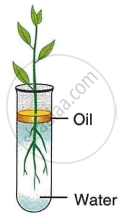Advertisements
Advertisements
प्रश्न
Study the diagram given below and answer the questions that follow:

- Name the process being studied in the above experiment.
- Explain the process mentioned in (a) above
- Why is oil placed over water?
- What do we observe with regard to the level of water when this set-up is placed in (1) bright sunlight, (2) humid conditions and (3) windy days?
- Mention any three adaptations found in plants to foster the process mentioned in (a) above
उत्तर
- Transpiration
- The loss of water from aerial sections of the plant in the form of water vapour.
- Oil is poured on water to stop evaporation-induced water loss.
- When the configuration is set,
- Transpiration causes the amount of water to drop in strong sunlight quickly.
- In humid conditions, the water level doesn't change much as the rate of transpiration decreases.
- The water level drops quickly during transpiration on a windy day.
- Leaves have morphological adaptations to control their transpiration rate, as follows:
- Thick cuticle: A quite thick cuticle could cover the leaves, e.g., banyan.
- Loss of leaves: As in cactus, some plants have leaves lost or absent.
- Narrow leaves: In order to decrease the surface area for transpiration, certain plants, such as Nerium, develop narrower leaves.
APPEARS IN
संबंधित प्रश्न
State whether the following statement is true or false. Rewrite the false statement correctly.
Water absorption mainly occurs through the root-hair.
Concentration of mineral nutrient elements is higher inside the root hairs than in the surrounding soil. How do roots take them in from the soil?
Choose the correct answer:
Wilting of plants occurs when ____________
The diagram below represents a layer of epidermal cells showing a fully grown root hair. Study the diagram and answer the questions that follow:

Draw a diagram of the above root hair cell as it would appear when a concentrated solution of fertilizers is added near it.
What is toxicity ?
The diagram given below represents the result of an experiment conducted on two freshly taken shoots of a green herbaceous plant. The lower ends dip in the water.

(i) What is the aim of the experiment?
(ii) Some parts of the stem in both the shoots have been removed. Name the conducting tissue in shoot A and in shoot B, that has been removed.
(iii) What are the results of this experiment?
Multiple Choice Question:
Water will be absorbed by the root hairs when:
In the zone of absorption, epidermal cells form unicellular hair-like extensions called ________.
Epiphytic plants like orchids absorb water vapours from air with the help of epiphytic roots having special tissue called ____________.
Paheli uprooted a rose plant from the soil. Most of the root tips, with root hairs, got left behind in the soil. She planted it in a pot with new soil and watered it regularly. Will the plant grow or die? Give a reason for your answer.
